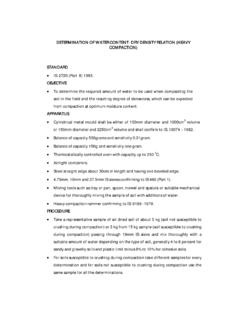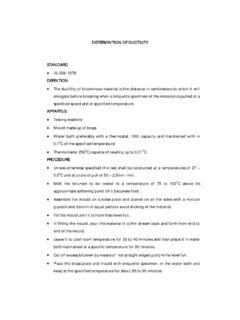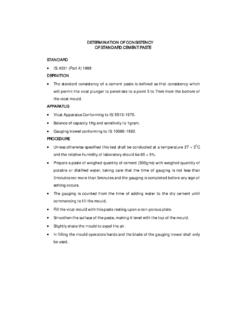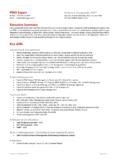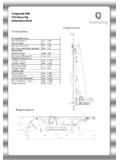Transcription of DETERMINATION OF LIQUID LIMIT- BY …
1 DETERMINATION OF LIQUID LIMIT- BY casagrande APPARATUSSTANDARD IS: 2720 (Part 5) LIQUID Limit is defined as the water content at which the soil changes from LIQUID state to plastic state. apparatus casagrande apparatus confirming to IS: 9259-1979. Grooving tool. Balance of capacity 500 grams and sensitivity Thermostatically controlled oven with capacity up to 2500 C. Porcelain evaporating dish about 12 to 15cm in diameter. Spatula flexible with blade about 8cm long and 2cm wide. Palette knives with the blade about 20cm long and 3cm wide. Wash bottle or beaker containing distilled water. Containers airtight and non- corrodible for DETERMINATION of moisture Take representative soil sample of approximately 120gms passing through 425 micron IS sieve and mix thoroughly with distilled water in the evaporating dish to a uniform paste.
2 The paste shall have a consistency that will require 30 to 35 drops of the cup to cause the required closure of the standard : LIQUID Limit test. Leave the soil paste to stand for 24 hours to ensure uniform distribution of moisture through out the soil mass. Remix the soil thoroughly before the test. Place a portion of the paste in the cup above the spot where the cup rests on the base, squeeze down and spread in to position with a few strokes of the spatula as possible and at the same time trim to a depth of 1cm at the point of maximum thickness. Make a clean, sharp groove by a grooving tool along the diameter through the centerline of the cam follower.
3 Drop the cup from a height of 10 + mm by turning the crank at the rate of two-revolutions/ sec,until the two halves of the soil cake come in contact with the bottom of the groove along the distance of about 12mm. Record the number of drops required to cause the groove close for the length of 12mm. Collect a representative slice of sample of soil approximately the width of spatula, extending from about edge to edge of the soil cake at right angle to the groove in to an air tight container and keep in the oven for 24hrs,maintained at a temperature of 1050 to 1100C and express its moisture content as the percentage of the oven dried weight.
4 Transfer the remaining soil in the cup to the evaporating dish and clean the cup and the grooving tool thoroughly. Repeat the operation specified above for at least three more additional trials (minimum of four in all) with soil collected in evaporating dish to which sufficient water has been added to bring the soil to more fluid condition. Fig: Divided soil cake before testFig: Soil cake after test In each case record the number of blows and determine the moisture content as before. The specimens shall be of such consistency that the number of drops required to close the groove shall not be less than 15 or more than 35.
5 REPORT Plot a flow curve with the points obtained from each DETERMINATION on a semi logarithmic graph representing water content on the arithmetical scale and the no of drops on the logarithmic scale. The flow curve is a straight line drawn as nearly as possible through the four or more plotted points. The moisture content corresponding to 25 drops as read from the curve shall be rounded off to the nearest second decimal and is reported as LIQUID limit of the This test should proceed from the drier (more drops) to the wetter (less drops) condition of the soil. This test may also be conducted from wetter to drier condition provided drying is achieved by kneading the wet soil and not by adding dry OF PLASTIC LIMIT AND PLASTICITY INDEXSTANDARDS IS: 2720 (Part-5) Plastic limit is defined as minimum water content at which soil remains in plastic Porcelain evaporating dish about 12cm in diameter.
6 Flat glass plate 10mm thick and about 45cm square or longer. Spatula flexible with the blade about 8cm long and 2cm in wide. Ground glass plate 20 x 15 cm. Airtight containers. Balance of capacity 500grams and sensitivity 0. 01gram. Thermostatically controlled oven with capacity up to 250 0C. Rod 3mm in diameter and about 10cm long. PROCEDURE Take representative soil sample of approximately 20g from the portion of the material passing 425 micron IS sieve and mix thoroughly with distilled water in an evaporating dish till the soil mass becomes plastic enough to be easily molded with fingers. In the case of clayey soils, leave the soil mass to stand for 24 hours to ensure uniform distribution of moisture through out the soil.
7 Form a ball with about 8 grams of this soil mass and roll between the fingers and the glass plate as shown in Fig: with just sufficient pressure to roll the mass into a thread of uniform diameter throughout its length. The rate of rolling shall be between 80 and 90 strokes/minute counting the stroke as one complete motion of the hand forward and back to the starting position again. Continue the rolling till the thread crumbles exactly at 3mm diameter. If the soil thread doesn t crumble exactly at 3mm knead the soil together to a uniform mass and roll it again. Continue this process of alternate rolling and kneading until the thread crumbles under the pressure exactly at 3mm diameter.
8 Collect the pieces of crumbled soil thread in an airtight container and determine its moisture limit test. Determine the plastic limit for at least two points of the soil passing 425 micron IS sieve. REPORT Report the individual and the mean of the results as the plastic limit of the soil to the nearest second At no time shall an attempt be made to produce failure at exactly 3mm diameter by allowing the thread to reach 3mm then reducing the rate of rolling or pressure or both and continuing the rolling with out further deformation until the thread falls a part. PLASTICITY INDEXDEFINITION The plasticity Index is defined as the numerical difference between its LIQUID Limit and Plastic Plasticity Index = LIQUID Limit - Plastic In the case of sandy soils plastic limit should be determined first.
9 When plastic limit cannot be determined the Plasticity Index should be reported as NP (Non-Plastic). When the plastic limit is equal to or greater than LIQUID limit, the plasticity index shall be reported as zero.
